Sports
Auburn Film Review: I’m Sick of the Spread
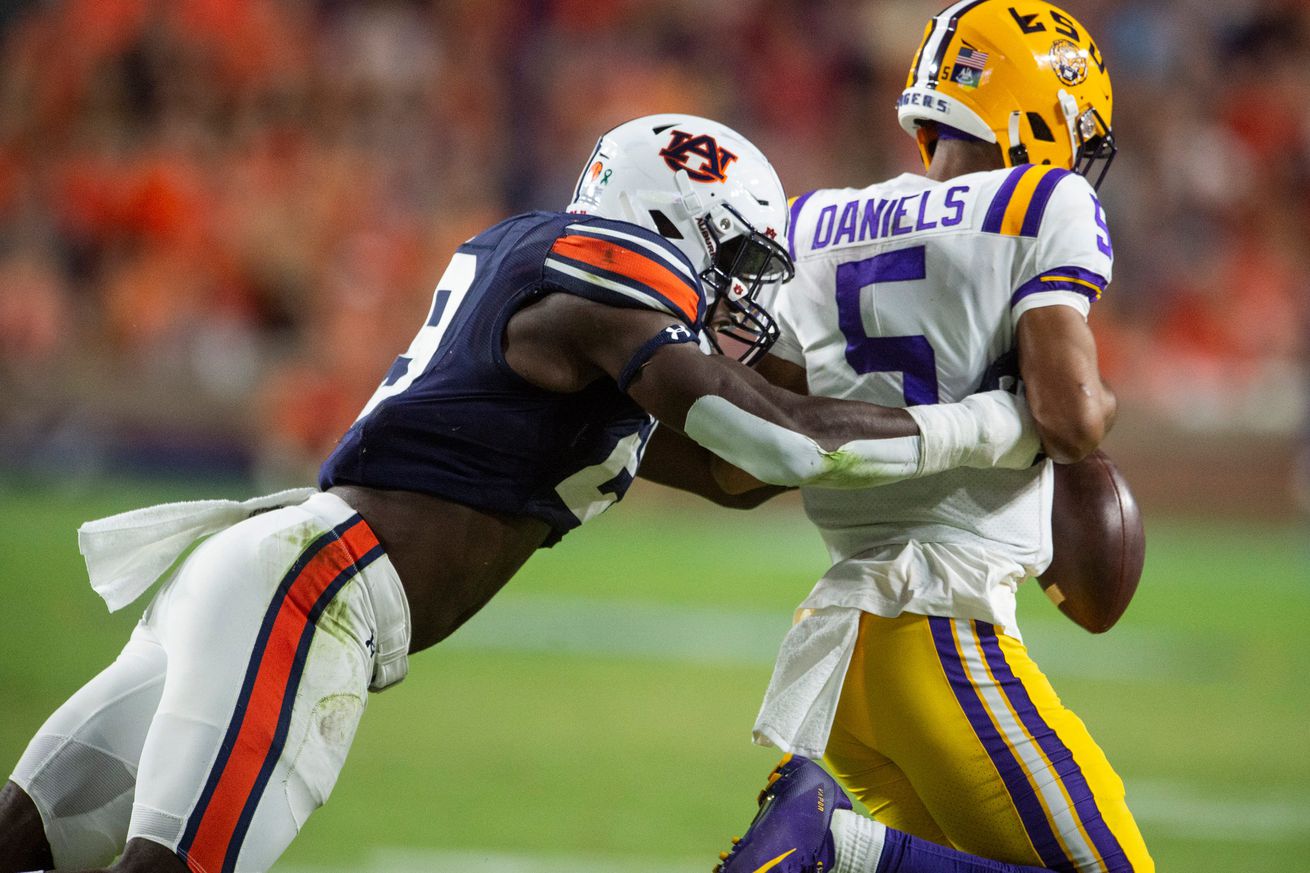

Seriously
Look, the “spread” offense is no longer a useful indicator of much of anything as it is defined in general discourse (that is to say, very loosely). There is so much diversity within offenses that like to spend a lot of their time with 3+ receivers on the field that it no longer tells you much of anything to use the term “spread.” If you look at the Rams, who live in 11 personnel (1 RB, 1 TE, 3 WR), you still couldn’t justify calling them a “spread” offense because of how much they like to condense their alignments and create extra gaps in the run game, the same way a heavy personnel team would. “Spread” offenses, to me, are no longer defined in any part by personnel, but entirely by how much they like to space out their receivers and play in space.
There was once a time when such alignments created massive advantages against teams built to stop the run with base personnel and bigger-bodied linebackers. The 2010s, despite being recently past, were a long time ago in the geologic time scale of college football. Teams are smaller, teams are very comfortable playing nickel and dime, and teams can take away pass concepts with 4 or 5 spaced-out routes. You can’t just align people wide and expect defenses not to be able to handle it anymore. You have to condense things at times, especially against man coverage, to create releases, scheme up separation, and help your receivers out. Additionally, you’re not seeing too many designed double moves to help punish teams in man. They’re very static in their routes and route structures both in scheme, alignment, and technique, which bodes ill against man coverage.
No, this isn’t the only problem with the offense. They don’t use nearly enough RPOs or designer play-action to create easy explosives for the QB in the passing game, the QB needs to pull the trigger on open receivers, and the pass catchers are playing shockingly bad football. While all that is true, they aren’t getting any help from their offense, which demands that they go make plays, go work through challenging progressions, and just win 1 on 1. It’s not THAT easy to call a successful offense, not with defenses comfortable defending spread alignments. Auburn had a simple, solid, replicable game plan on the back-end. They aren’t some special defense, so this should scare LSU fans. Without major adjustments, things could get very dark against better defenses like Alabama, Arkansas, and Texas A&Mid.
The Problem With Spread Alignments
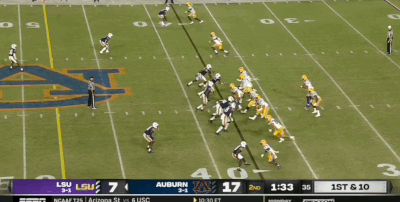
My biggest problem with this offense, besides their criminally low usage of backfield action like RPOs and play-fakes to create conflict and make life easier on the QB, is how spread-out from one another their pass catchers are by alignment. This clip is a good example of how defenses can punish that. Auburn is just in cover 1 here against 4 verts, or in Kelly terminology, “Charlie”. When you’re this spread out, the only way anybody is getting open against tight man coverage is if they straight-up win their route in a major way. Against competition, that doesn’t happen as much as you need it to. When you condense your alignments, you can play routes off of each other to create conflict, as well as create rubs/natural picks, easier releases, and natural separation off the ball.
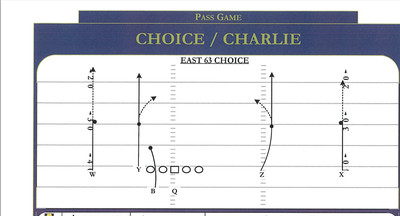
The outside receivers have the choice to stop their routes if they can’t get any vertical separation. If they can’t get any vertical separation against man coverage, those stop routes aren’t helping you at all, since that guy is right on you anyway. You’re putting incredible pressure on them to just win their route. As I wrote about here, there are better ways to run 4 verticals that actually create natural separation and conflict instead of asking people to win. Additionally, LSU’s receivers aren’t doing anything of nuance in their releases, stems, and breaks on routes to generate separation. They’re just running the basic route path and hoping they get open. If you go turn on Justin Jefferson and DaVante Adams, there is a ton of nuance throughout the route that helps you get open against man coverage. If you’re going to spread things out like this, you have to be able to win like that and they aren’t.

This is a good example of the above. Boutte doesn’t have a safety over top of him, but he gets worked on this route by the corner, who isn’t as good as he is, because he just straight outside releases into his route. Any DB who is mildly athletic can cover you if you are just running straight lines along the sideline. Ja’Marr Chase is so good on these sideline go-balls because he does a lot of things at the line to generate good releases, and when he’s in his route, plays with good hands and does a good job maintaining leverage. None of that here. Additionally, Jayden Daniels isn’t accurate enough to make the precise throws that you will have to make, even with great WR play, to complete go balls on the sideline against tight man. You have to be precise enough to drop it in the bucket with just a step or two of separation or, if the WR has low-outside leverage, put it to the back-shoulder. He just doesn’t have that high-end accuracy.

One (low-percentage, requires a more accurate QB) concept that LSU runs EXTREMELY often is “Shock,” which is a Sean Payton staple pictured below.
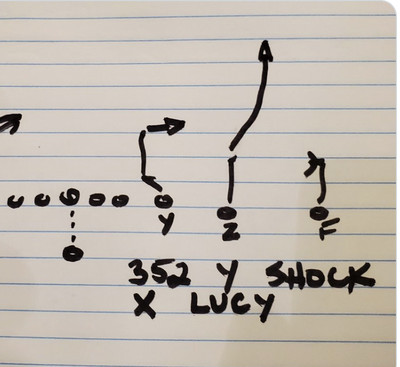
The idea is to take the slot fade against man coverage. That said, it’s a low-percentage throw that requires an accurate QB, and it requires the WR to get vertical on his man. Jenkins gets completely shut down on his route here, which happens a lot to the slot fade runner for LSU on this play.
Daniels doesn’t look that way though, he’s trying to get a conversion on the double slant which isn’t a bad call against cover 1 on 3rd and 4. Nabers is trying to do something nuanced here, which I applaud. He is trying to sell his route outside and vertical to get the CB to turn his hips, which would allow Nabers to break it off and get inside leverage on the slant. He, in my opinion, goes too far up and out, which prevents him from being able to break into his slant with any degree of quickness, which allows the corner to recover and stay on him. A good idea here, but bad execution. I’d work this in INDY if I were coaching WRs at LSU.
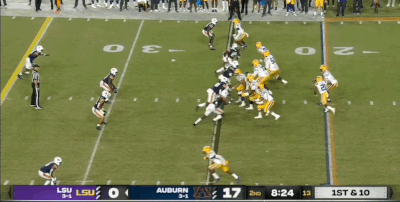
Even when they DO things like switch releases, they’re spaced out enough that defenses can easily handle them. This is still a spread look.
Not Pulling the Trigger
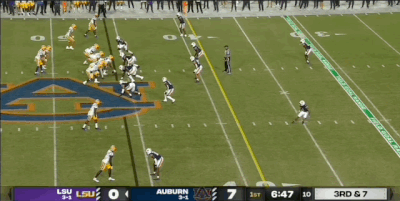
Pre-snap, this is such an obvious Tampa-2 rotation that Daniels does not get an excuse for not targeting the route that’s good against Tampa-2 here just because it looked a tiny bit different before the snap. In Tampa-2, the safeties have to end up outside of the number 2 receivers because they have deep half responsibility, which means he has to account for anything vertical on the outside. To deal with the middle, you have a linebacker playing deep middle, which is known as playing “middle-read” or “running the middle.” To the field, Boutte’s seam route pops inside the field safety and the middle runner has no chance of matching him vertically. Throw the touchdown, dude. Instead, he panics and throws late out of structure, out of bounds.
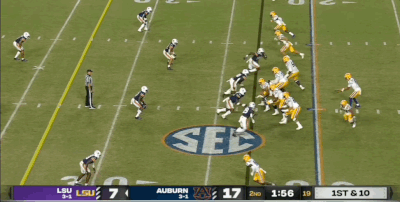
This time the slot fade on shock actually DOES get open enough to throw. At the top of Daniels’ drop, Boutte is even with his man. Coaches will tell players of multiple positions “if he’s even, he’s leavin,” which means that he will be able to get vertical separation. Daniels needs to see that and drop this in the bucket over the top. Additionally, it’s first down so there’s no issue with a shot falling incomplete. Throw the ball.
Tough sledding ahead folks, the defenses get better than Auburn.


